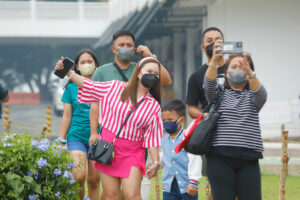Vog and health

More than 200 people fell ill from Taal’s volcanic smog or vog, prompting the Department of Health (DoH) to put the medical community under “white alert” in Calabarzon.
Over the weekend, Civil Defense Administrator and National Disaster Risk Reduction Management Council Executive Director Undersecretary Ariel Nepomuceno said that there had been at least 263 health consultations due to the vog.
Volcanic fumes, like vog, can be hazardous to health and can be life threatening. While it is colorless, vog comes with a visible haze and pungent odor similar to fireworks or a burning match.
Volcanic gas emissions can pose environmental and health risks to nearby communities, said the United States Geological Survey (USGS). It is easy to understand why. Like urban, industrial, and other pollution sources, vog contains toxic contaminants, mostly sulfur dioxide (SO2) and acid particles. It explained that vog is comprised of gas and an aerosol of tiny particles and acidic droplets created when SO2 and other gases emitted from a volcano chemically interact with sunlight and atmospheric oxygen, moisture, and dust.
Particularly problematic is the PM2.5 — particulate matter less than 2.5 micrometers in diameter which can settle deeply in the lungs when inhaled — which in vog is mainly composed of acid and neutral sulfate particles. These particles, that are also found in vehicle exhaust and smoke from fires, are smaller than the width of a human hair, noted the USGS. Meanwhile, SO2 can irritate the skin and the tissues and mucous membranes of the eyes, nose, and throat.
While sensitivity to vog varies, individuals with pre-existing medical conditions are expected to be at highest risk, depending on the amount of emissions, their distance away from the eruptive vent, and wind direction from day to day. Also with increased sensitivity are children, pregnant women, and the elderly.
As classes were suspended in Metro Manila due to haze, the Philippine Atmospheric, Geophysical and Astronomical Services Administration (PAGASA) said that meteorological conditions resulted in smog formation, and not vog, in the National Capital Region. Even so, smog also brings with it a number of health hazards. “This (smog) occurs when very small particles get trapped close to the surface due to the presence of a thermal inversion, high humidity, and calm wind conditions. These floating minute particles in the air could be from smoke, pollutants, or volcanic aerosols,” the Philippine Institute of Volcanology and Seismology, better known as Phivolcs, said as it explained that the haze the NCR suffered from was not vog.
DEALING WITH VOGThe International Volcanic Health Hazard Network (IVHHN), an umbrella organization for all research and dissemination of information on volcanic health hazards and impacts, provided guidance on how to prepare for and take protective actions to reduce the impact of vog on individuals.
In preparing for vog, the IVHHN said that it is important to understand the hazard. It is helpful to be familiar with air monitoring sources as well as SO2 and PM2.5 advisory codes/levels. Learning about wind conditions is also key to predicting if and when one might be affected by vog. Since vog can cause illness or exacerbate an existing one, it is important to keep medications handy such as those for asthma or other respiratory conditions. The group added that one can assume that asthma could get worse during periods of high vog, therefore, seek medical assistance as necessary if an individual is having asthma symptoms or other conditions when exposed to vog.
The IVHHN added that it is important not to smoke and to avoid second-hand smoke. Those exposed to vog must also stay hydrated to help loosen congestion. It added that warm or hot liquids may help some people. In managing congestion or irritation, over-the-counter nasal sprays or eye drops can help to reduce symptoms. If symptoms don’t improve, it is advisable to seek immediate medical care.
Other ways by which one could care for themselves and their family is by wearing N95-type particle-filtering respirators/masks as needed. But the IVHHN also said that children should not use N95 masks because they are sized for adults.
Also, outdoor exercise or exertion increases one’s chances of being affected by SO2 gas and/or PM2.5. So, staying indoors is the prudent action. The group said that, if possible, people should stay indoors and close all outside doors and windows when there is vog. (At the same time, there is a need to beware of becoming overheated.) Additionally, when staying indoors, eliminate other sources of pollutants such as smoking, candles, or incense. Even if the house is not well-sealed, the IVHHN said it may still offer some protection. If a room can be closed up, an appropriate air-cleaning device can help reduce the levels of vog.
However, one may consider moving to indoor areas that are better-sealed. An individual may consider temporarily relocating, if necessary. To minimize air infiltration while inside the vehicle, temporarily close the windows and vents, and turn the fan and air conditioner off.
Finally, staying updated on information coming from the government and official sources is crucial.
“We also remind the public to heed the advisories of the Department of Health (DoH) as well as the warnings being issued by the Philippine Institute of Volcanology and Seismology for the safety of everyone. Phivolcs and the DoH have been issuing warnings on the health hazards posed by the volcanic smog. We are amplifying these advisories and warnings for public awareness,” said Undersecretary Nepomuceno.
Teodoro B. Padilla is the executive director of Pharmaceutical and Healthcare Association of the Philippines (PHAP). PHAP represents the biopharmaceutical medicines and vaccines industry in the country. Its members are in the forefront of research and development efforts for COVID-19 and other diseases that affect Filipinos.
Teodoro B. Padilla is the executive director of Pharmaceutical and Healthcare Association of the Philippines (PHAP). PHAP represents the biopharmaceutical medicines and vaccines industry in the country. Its members are in the forefront of research and development efforts for COVID-19 and other diseases that affect Filipinos.




